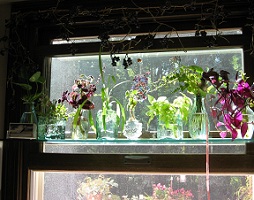Genesis 1:12 The land produced vegetation: plants bearing seed according to their kinds and trees bearing fruit with seed in it according to their kinds. And God saw that it was good.
 One of the miracles of plants is their ability to reproduce by means other than simply seed (which is miraculous in and of itself). While seeds form as a result of pollination of flowers (the plant’s natural sexual reproduction function—the birds and bees for the plant world), many of these same plants can also be grown from cuttings or divisions.
One of the miracles of plants is their ability to reproduce by means other than simply seed (which is miraculous in and of itself). While seeds form as a result of pollination of flowers (the plant’s natural sexual reproduction function—the birds and bees for the plant world), many of these same plants can also be grown from cuttings or divisions.
Moreover, some plants can only be obtained through asexual reproduction (by cuttings or divisions) because the seeds will produce flowers that are not true to their parentage. This happens because of genetic variability within a plant and the careful hybridization that was used in forming the original hybrid. Asexual reproduction is basically cloning because the resulting plant has the same genetic makeup as the parent.
Given the hard work involved in carefully breeding for special characteristics, many hybrids are patented which means that asexual reproduction cannot be used to make plants for sale without prior permission from the patent owner. My interest in propagating with cuttings or divisions is to increase my personal collection of certain plants or to make the overwintering of them easier indoors. You know how it is—so many plants, so few windows. Alas, I wish I had a greenhouse. There, I said it! A greenhouse would provide hours of entertainment and give me more space to fill with the plants I love. And I love lots of plants—which you can interpret either way and it’s a true statement.
Cuttings do not take up nearly the space of a whole end-of-the-season-plant and can be grown in a window with supplemental lighting to help them make it through the winter. I probably do this less because I want to multiply anything for my own garden and more because I like certain varieties and want to hold them over. My huge mother plant of Martha Washington geranium went out to the curb with a FREE sign on it because I have two baby plants in its place. I gave away one of my gigantic strawberry pots and will divide and repot my remaining strawberries next spring. I’m thinking of investigating one of the faddish “upside down planters” to see if they actually work. My hope is that it will work better than a strawberry tower at keeping birds and slugs from nibbling.
 I have a couple of geranium varieties that will come indoors as well as some impatiens and coleus. Many cuttings will be started in vermiculite (as my post March into Spring illlustrated), but others will look simply lovely in little glass vases above my kitchen sink. They help to cheer a long winter during which I will look out my window and see day after day of snow and cold. But to see it, I’ll have to look beyond my indoor reminder of perpetual spring on my windowsill.
I have a couple of geranium varieties that will come indoors as well as some impatiens and coleus. Many cuttings will be started in vermiculite (as my post March into Spring illlustrated), but others will look simply lovely in little glass vases above my kitchen sink. They help to cheer a long winter during which I will look out my window and see day after day of snow and cold. But to see it, I’ll have to look beyond my indoor reminder of perpetual spring on my windowsill.
I have also separated and repotted my amaryllis bulbs for winter bloom. Some varieties of my amaryllis are oddballs and don’t leaf and flower when I expect them to. Others are as predictable as can be. I try to let the foliage die back at the end of summer by drying them out and then remove the spent foliage and let it rest in the dark. Then I repot them for this year’s flowering. It takes somewhere between 7-12 weeks after a rest for many amaryllis to bloom again.
As some of my cuttings take root and grow to sizeable plants themselves, they’ll become stock plants for next year’s garden and I will take cuttings all winter to have enough for planting in the spring. It’s part of how I can stay encouraged during the winter that hope springs eternal.